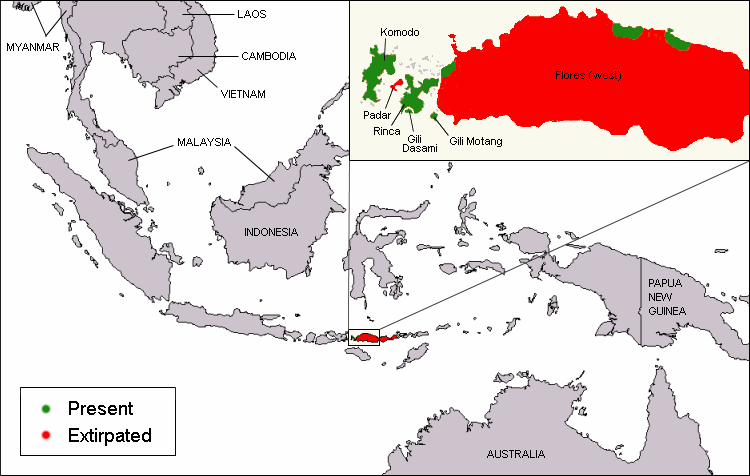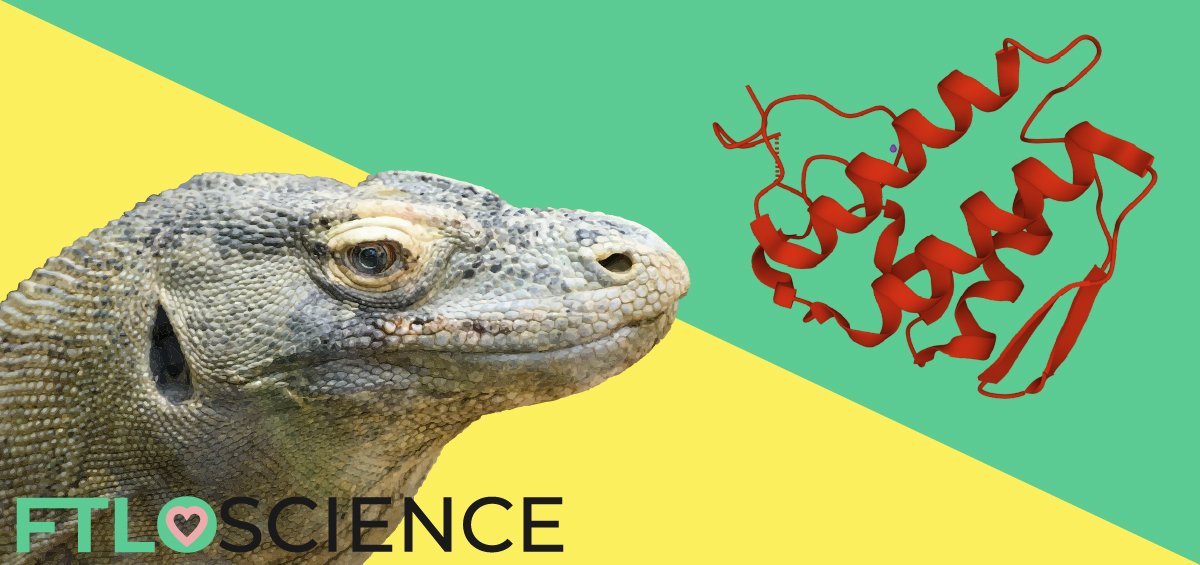On the tropical island of Komodo in Indonesia, just a few hours’ boat ride from the tourist hotspot of Bali, Komodo dragons rule the roost. These large reptiles are apex predators, hunting and devouring almost anything in their path. Their evolutionary successes are aided by a cocktail of venomous proteins secreted in their jaws, some of which might have future therapeutic applications.
Komodo dragons are venomous, cold-blooded reptiles only found on 5 islands in Indonesia. Once thought to infect their prey with bacteria living in their mouths, we now know that they kill with the help of venomous proteins found in their saliva. Komodo dragons also produce other special proteins in their blood that help them survive as apex predators in the wild.
Enter the Komodo Dragon
Fearsome Predators
Closely related to monitor lizards and goannas, the Komodo dragon (Varanus komodoensis) is the world’s largest living lizard species. They evolved to this gigantic size around 15 million years ago in what is now Australia, before the continents collided and they migrated across into the Indonesian islands.
Though they prefer to scavenge (Komodos can detect the smell of carrion up to 9.5 km away!), they are also fearsome hunters, stalking and chasing their prey across long distances. Hunting both alone and in coordinated groups, they can take down anything from birds to buffalo and have even been known to attack humans.
Komodo dragons can grow up to 90 kg in weight and 3 m in length. Their large size and powerful bite are supplemented by the ability to chase prey across long distances, reaching speeds of 20 km/h. In addition, they can dive up to 4.5 m under the water. Young Komodos can also climb trees with the help of their sharp claws, which they often do to escape cannibalism by their larger counterparts.
Komodo dragons have a keen sense of smell, using their tongue to pick up scents. Its forked tongue helps to better distinguish the direction of smells, much like having two ears helps us to discern the direction of sounds. Moving its head from side to side while walking allows the Komodo to sample a larger area for new scents.
Komo-doh! Mistaken for Having Bad Breath
Up until early this century, it was thought that Komodos had ‘dirty’ mouths since they were often spotted scavenging and feasting on carrion. This dirtiness would be a breeding ground for species of septic bacteria, that would infect the blood of whatever they sank their teeth into, causing their prey to die a slow and painful death.
However, in a 2013 study, it was found that their saliva contained no such bacteria, but that Komodo dragons produce venom that caused these effects to help them hunt prey.
In fact, Komodo dragons have good mouth hygiene. They spend time lip-licking and rubbing their head in leaves after eating, removing excess meat from their mouths to prevent disease. They also regurgitate pellets of hair and other indigestible material from their stomachs, making sure to clean themselves afterward. In this respect, Komodos are just giant, hairless cats.
Komodo can Create Unique Proteins
Venomous Saliva
In 2005, a team of researchers took a closer look at the saliva of a Komodo dragon after noticing that its bite-induced side effects were closely related to envenomation. They found a variety of venomous peptides (short protein chains) using chromatographic techniques, including natriuretic, kallikrein and CRISP toxins, along with a toxin unique to lizards, type III phospholipase A2 (PLA2).
Together, this cocktail of toxins causes a lowering of blood pressure, rapid swelling, prolonged blood loss and severe pain in Komodo bite victims. This was consistent with the symptoms shown in snake bite victims, leading the researchers to conclude that Komodo dragons produce their own venom.
This was confirmed in 2009 when MRI scans of a Komodo dragon skull showed the presence of two venom glands in its lower jaw. Snakes, on the other hand (despite not having any), have venom glands located on their upper jaws.
Antibacterial Peptide VK25
In addition to creating venomous peptides, Komodo dragons’ blood contains an interesting antibacterial peptide, VK25. VK25 belongs to a class of proteins called cationic antimicrobial peptides (CAMPs); although their mechanism of action isn’t fully understood, they are effective against a wide range of gram-positive and gram-negative bacteria, viruses and even fungi.
Researchers used VK25 as a template to synthesize a near-identical peptide, which they named DRGN-1. DRGN-1 was tested and shown to be effective as an antimicrobial agent. Tests on mice showed that it could also promote healing in infected wounds by inducing skin cell migration over the wound.
Other Genetic Adaptations
Studying specific genes in the Komodo dragon genome uncovers several other important adaptations that have aided in its survival. Researchers found beneficial mutations in their mitochondrial and cardiovascular proteins, which would explain their remarkable stamina and heart function.
In addition, Komodos possess mutations in several genes that improve the regulation of platelet activities, which are responsible for processes like blood clotting and wound healing. We know that they produce venom with anticoagulant properties, so this could also help to counteract the effects of getting bitten by other Komodos (they are known for fighting and even cannibalism). These mutations can also reduce blood loss after a Komodo sustains an injury, leading to higher survival rates.
Future Research into Komodo Peptides
Toxins produced by Komodo dragons include natriuretic peptides, which have been studied for their ability to suppress tumor growth. There is experimental evidence to suggest that these peptides can affect the epidermal growth factor (EGF) pathway that promotes malignant tumor growth in lung, breast, prostate and pancreatic cancers. Natriuretic peptides can prevent EGF from binding in cells, therefore showing its potential to be a board-range anticancer agent.
As we learn more about the Komodo genome, we can use it as a template for creating our own synthetic peptides. Advances in such peptide therapies, a form of biologic drug, might be the next step for chemotherapy research. There is evidence that these peptides can better target cancer cells while being less toxic than traditional anticancer drug counterparts.
Antibacterial and antifungal resistance is a known public health issue, especially due to the extensive use of these drugs in agriculture. Since these antibiotic peptides work differently compared to existing antibiotic drugs, they can serve as possible alternatives if conventional treatment fails. It is important that we keep developing new strategies in the evolutionary arms race against these superbugs: drug-resistant strains of bacteria and fungi.
Komodo Dragon Conservation
Komodo dragons are creatures that are finely tuned and highly evolved for survival in their habitat. However, their adaptations are no match for hunting, climate change and habitat destruction, among other human activities. Their ecological range has contracted to just several tiny islands in the south of Indonesia, with the likelihood of their habitat shrinking even further to the point of extinction. There is clearly a great deal that we still have to learn about these magnificent creatures. Conservation efforts must be stepped up if we want to continue to observe and study this endangered apex predator.

About the Author

Sean is a consultant for clients in the pharmaceutical industry and is an associate lecturer at La Trobe University, where unfortunate undergrads are subject to his ramblings on chemistry and pharmacology.




